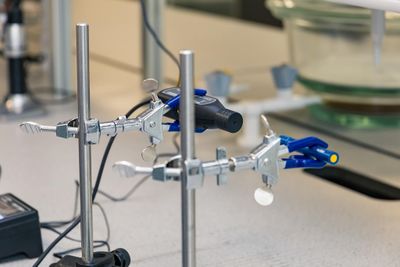Experiments with gamma rays
Contents
Experiments with $\gamma$ rays
$\gamma$ rays are high-energy photons. They typically originate from the spontaneous emission of a nucleon (proton or neutron). Using our Cs-137 source at the UoW, we address the following particular topics surrounding the use of radiosources:
- The different types of radiation and their main properties, including the existence of background radiation.
- The randomness of radioactive emission and its associated statistical aspect.
- The inverse square law for uncollimated $\gamma$ radiation.
- The attenuation of radiation in matter.

What is radioactivity and where does it come from?
Radioactivity is everywhere. In the form of decaying C-14 atoms, it is in about one of every other cell of our body, amounting to roughly 4000 disintegrations per second (per person). One finds it in bananas, due to their high level of potassium. In greater amount, we find it from cosmic radiations and, for the main part of the ambient background, from radon. A more useful measure of radiation than the number of disintegration per second (which unit is the Becquerel) is the amount of energy deposited in matter: one Joule in a kg of matter corresponds to one Gray (Gy). Since various types of radiation have varying effects on living tissues, which is what is of greatest concern when measuring radioactivity, one uses a weighted quantity, the effective dose delivered, with units in Sieverts (Sv). Some orders of magnitudes are in order here: the worldwide average dose from background radiation is about 2.4mSv/year. Living within 50 miles of a nuclear power plant yields 0.09$\mu$Sv/year, which is considerably less than the single event of eating a banana (0.1$\mu$Sv) or living within 50 miles of a coal power plant (1$\mu$Sv). On average, someone receives a dose of 10$\mu$Sv per day. A chest X-ray delivers 20$\mu$Sv, the extra dose in Tokyo after the Fukushima accident was of about 40$\mu$Sv in the following weeks. A mammogram is 400$\mu$Sv. The legal limit for a US radiation worker is 50mSv per year. Then start the harmful doses: 100mSv a year shows correlation with developing a cancer. Radiation poisoning is felt at about 400mSv if taken over a short time. 4Sv are lethal if no prompt treatment is received. 8Sv are lethal regardless of action taken.
In Wolverhampton, we have some micrograms of Cs-137 whose relaxations from Cs atoms (in fact Ba atoms following a $\beta$ transition of Cs) provide us with a 370kBq radiosource, that we use for a variety of outreach experiments and demonstrations.
Safety issues
The experiment involve a radioactive source (shown left) and specific safety procedures must be adhered to. We expect maturity and good behaviour from the students. Eating/drinking/applying cosmetics is not allowed during the demonstration and following the staff instructions regarding safety issues and practices in the laboratory are mandatory at all times. Safety instructions will be explained before the demonstration, in particular the procedure to follow in case of an emergency (e.g., fire alarm).
Transfer of the radio-source from its storage locker will be made by the university radiation protection officer. The demonstration will be conducted in a properly equipped and maintained laboratory (in the Rosalind Franklin building). The demonstration will be carried out at all times by a qualified Physicist, with a Diploma of Advanced Studies in Corpuscular Physics and experience in overlooking laboratory sessions with University students handling similar radiosources. It will use a Cs-137 370kBq sealed source, from the last generation in design for safe handling, experimentation, storage and security. Sealing means that the radioactive material is permanently fixed in a capsule designed to prevent release and dispersal of the radioactive material under the most severe conditions which are likely to be encountered in normal use and handling. Spreading of Cs is the most dangerous aspect of this common radioactive element, that is one of the most common waste in nuclear incidents (Tchernobyl and Fukushimas) or contaminating agent following nuclear-weapon tests. The sealing of our source means that Cs is confined and that the risks associated to its dispersion in the surroundings are eliminated. Students should maintain at a distance from the setup (a meter) during the demonstration, in particular, they should not be in contact with the source itself or its support. They will be given the opportunity to participate actively and taking data, without having to interact with the radiosource. The exposure of students and staff will be kept considerably below the legal dose limits (much less than is delivered by ambiant radioactivity).
Part of the demonstration will involve a presentation and discussion of the risks associated to radioactivity, which either tends to be feared to an irrational degree or on the contrary simply ignored. Teaching about ionising radiations helps people to develop balanced attitudes to the subject, neither blasé nor apprehensive.
Sessions
- On 3 May 2017, with Dudley Sixth Form college's students (15 students).

